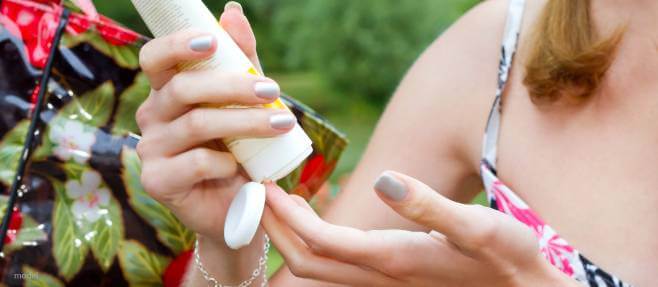The Ultimate Sunscreen Guide

Sunscreen is vital to protecting the skin from harmful ultraviolet rays. UVA ray damage quickens the aging process, which causes wrinkles and discoloration. UVB damage leads to sunburn and is a primary risk factor for skin cancer. The daily use of a high SPF broad spectrum sunscreen is by far the most effective way to shield the skin from overexposure to both UV types
While there are currently hundreds of sunscreen options to pick from, finding the right sunscreen for your particular needs can be difficult. In this post, we will cover sunscreen basics. Learn all you need to know about sunscreen and protecting your skin with this ultimate sunscreen guide.
Physical Sunblock vs. Chemical Sunscreen
Physical Sunblock such as zinc oxide or titanium dioxide sits on top of the skin and deflects the sun’s harmful rays. This type of sunscreen is unlikely to clog pores as it remains on the skin’s surface, and they can even provide a moisturizing benefit. Compared to chemical sunscreen, however, sunblock can also be less resistant to sweat and water. The heaviness and high visible nature of sunblock also results it one big drawback: it does not blend into the skin very well and often leaves behind white streaks. To avoid streakiness, look for sunblock’s in tinted versions for a more even, natural look.
Chemical Sunscreens work by blending chemicals such as avobenzone, octinoxate, octisalate or oxybenzone into the skin. These chemicals work to convert UV rays into heat to avert it from absorption by the skin. Compared to sunblock, chemical sunscreens are much thinner and can quickly and fully blend into the skin (although one must wait 30 minutes after application for them to take effect and provide full protection). However, chemical sunscreens are more likely to clog pores or cause skin irritation.
To learn more about the differences between chemical sunscreen and sunblock see this blog post.
What is SPF and How Much Do I Need?
SPF, or sun protection factor, tells you how long it would take the sun’s UV rays to burn you versus how long it would take with no sunscreen at all. If wearing SPF 15, it would take you 15 times longer to burn than if you were wearing no sunscreen at all.
Determining how much you need can get a little complicated. It all depends on how sensitive you are to the sun, how much time you’ll be spending in the sun, if you’ll be in the water, and if you’ll have a chance to reapply. Higher SPF is not always better, especially in cases where people falsely equate a high SPF with more time in the sun and less need for re-application.
In general, an SPF of at least 30 is recommended if you’ll be spending extended time outdoors. Reapply every 2 hours, or immediately if you’ve been swimming.
What Does “Broad Spectrum” Mean?
Broad spectrum sunscreen protects proportionally against both UVA and UVB rays. If the label says Broad Spectrum SPF 30, you’ll get 30 times the protection for both types of ultraviolet radiation.
In general, UVA rays cause skin aging, which leads to wrinkles and discoloration. UVB rays cause sunburn and the type of damage that puts you at risk for skin cancer. You need protection from both, which is why we encourage patients to always go with a broad spectrum formula.
Sweat or Water Resistant vs. Sweat or Water Proof
The terms “waterproof” or “sweatproof” imply your sunscreen is completely unaffected by sweat or water. However, this isn’t true for any sunscreen, which is why these terms have been banned by the FDA since 2012.
Instead, sunscreens can credibly claim to be sweat resistant or water resistant. Labels further differentiate by claiming whether SPF effectiveness remains the same after 40 or 80 minutes in the water.
Be wary of this labeling. Water resistant testing is done in highly controlled fresh-water conditions. Chlorine, salt water, movement while you’re swimming, or toweling off versus air drying can all alter the effectiveness of your sunscreen. Thus, it’s often better to reapply sometime before the resistance limit listed on the label.
The Proper Way to Apply Sunscreen
To ensure you’re properly covered, follow these steps:
- Use a full shot glass worth of sunscreen to cover your entire body
- For the face alone, use a nickel-sized drop
- Apply sunscreen before you get dressed, then reapply to uncovered areas
- Using a spray? Create an even sheen over the whole body
- If using chemical sunscreen, apply 30 minutes before sun exposure for full absorption
- Don’t forget to apply around your eyes, the tops of your ears, front and back of your neck, hands and feet, scalp and lips
When to Reapply Sunscreen
Use sunscreen every day you’ll be outdoors, even when it’s cloudy. On cloudy days up to 80% of the sun’s radiation may still reach your skin. Be sure to reapply every 2 hours, or as soon as you exit the water after swimming.
Are Spray on Sunscreens Effective?
While spray on sunscreens can be effective, but most people don’t apply enough to get the full protection. If using a spray, hold the nozzle close to your skin and continuously spray until you see a wet, even sheen. Follow up by rubbing it in.
Some sprays may contain lung irritants which can be dangerous if you breathe them in, so spray in an area free from wind. Avoid spraying your face by spraying into your hands first, then rubbing it on.
Can Sunscreen Go Bad?
Sunscreen can expire which can decrease its effectiveness. Using expired sunscreen is just as bad as using no-sunscreen at all!
The FDA requires sunscreen to honor its labeled SPF for at least three years. If your sunscreen has an expiration date, never use it past this date regardless of this three-year limit. If your sunscreen does not have an expiration date, use a permanent marker to label it with the purchase date. Throw it away before three years have passed.
Store your sunscreen out of the heat and out of direct sunlight. If your sunscreen is stored improperly it may expire well before this three-year limit. If you notice any change in color or consistency, it’s time to discard it for new product.
Disclaimer: The contents of the Westlake Dermatology website, including text, graphics, and images, are for informational purposes only and are not intended to substitute for direct medical advice from your physician or other qualified professional.
